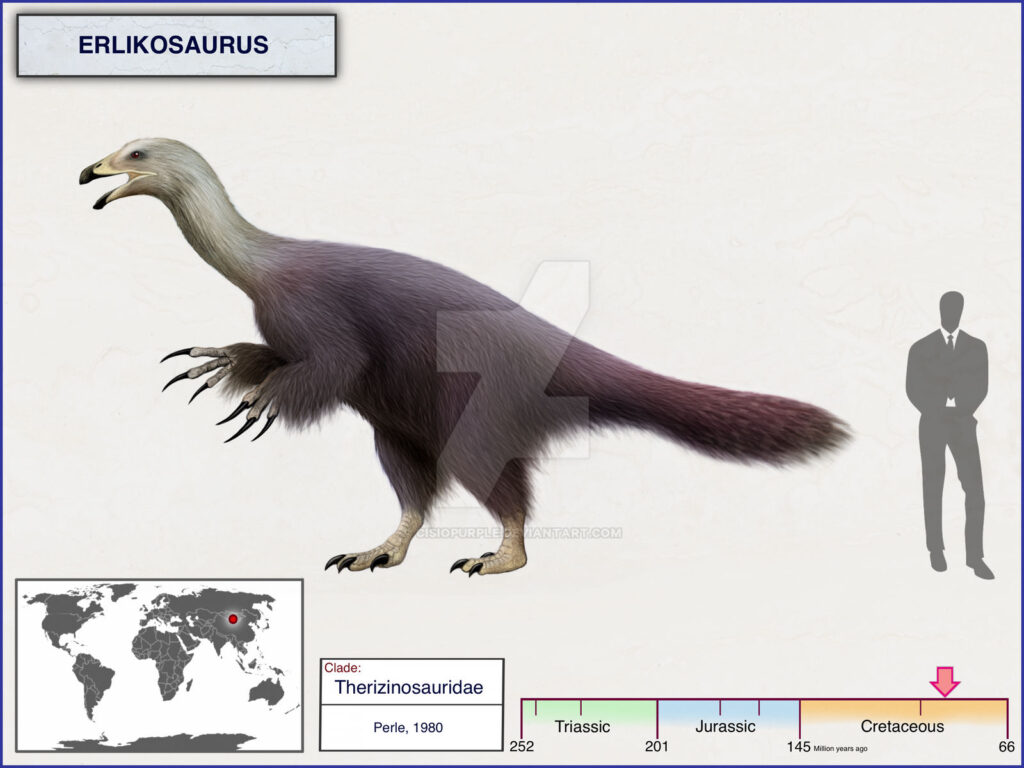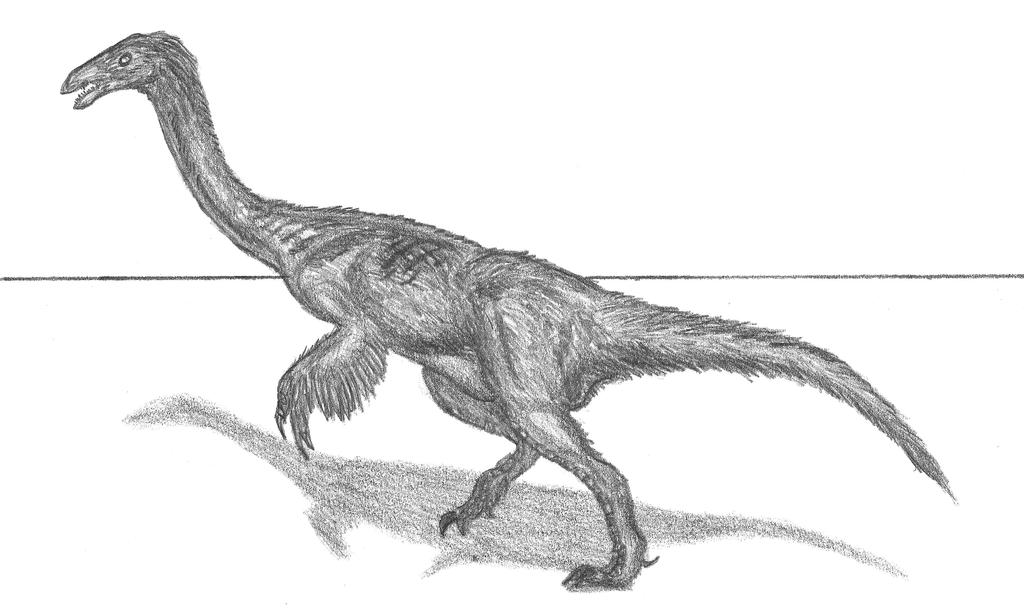Dinosaurs, with their incredible array of shapes, sizes, and behaviors, have captivated human imagination for centuries. Among these enigmatic creatures, Erlikosaurus stands out as a truly fascinating specimen from the ancient world. This omnivorous dinosaur, which inhabited our planet millions of years ago during the Late Cretaceous period, offers a rich tapestry of scientific intrigue and discovery.
In this article, we will delve into the discovery, physical characteristics, feeding habits, habitat, behavior, and other aspects of this incredible dinosaur.
Introduction
Erlikosaurus, derived from the name of the god of death in Turkic mythology, was a dinosaur species that lived during the Late Cretaceous period, approximately 90 to 70 million years ago. It belongs to the theropod group of dinosaurs, which includes other famous carnivorous dinosaurs like Tyrannosaurus rex and Velociraptor. However, Erlikosaurus stands out as it was not solely a carnivore but rather an omnivorous dinosaur.
Key Attributes of Erlikosaurus

| Name | Erlikosaurus |
|---|---|
| Size | Approximately 6 to 7 meters (20 to 23 feet) in length |
| Age | Late Cretaceous (approximately 90 to 86 million years ago) |
| Diet | Omnivorous, feeding on plant material and small prey |
| Classification | Kingdom: Animalia, Phylum: Chordata, Class: Sauropsida, Superorder: Dinosauria, Order: Saurischia, Suborder: Theropoda, Infraorder: Therizinosauria, Family: Therizinosauridae, Genus: Erlikosaurus |
| Habitat | Wooded environments and forested areas |
| Distribution | Found in Asia, primarily in Mongolia and China |
| Unique Features | Long neck, small head, and large sickle-shaped claws on its hands |
| Behavior | Believed to be a slow-moving dinosaur with omnivorous feeding habits |
| Predators | Shared its ecosystem with larger carnivorous dinosaurs |
| Cultural Significance | Fascinating to paleontologists and dinosaur enthusiasts |
| Fossil Record | Well-preserved fossils found in Asia, providing insights into its anatomy and evolutionary relationships |
Discovery and Naming of Erlikosaurus
Erlikosaurus was first discovered in the late 1990s in the Gobi Desert of Mongolia by a team of paleontologists led by Dr. Altangerel Perle. The fossils found included several partial skeletons, allowing scientists to reconstruct its appearance and understand its lifestyle. The name Erlikosaurus, given to this dinosaur, reflects its impressive nature and the mythology associated with the region.
Physical Characteristics of Erlikosaurus
Size and Weight
Erlikosaurus was a medium-sized dinosaur, measuring approximately 20 feet in length and standing about 6 feet tall at the hips. It weighed around 1,500 to 2,000 pounds, making it relatively lightweight compared to some of its larger carnivorous relatives.
Skull and Teeth
The skull of Erlikosaurus was long and slender, with a rounded snout and a beak-like structure at the tip. It had a row of small, sharp teeth in the front of its jaws, suitable for tearing and slicing plant material, as well as capturing small prey.
Limbs and Posture
Erlikosaurus had a bipedal stance, walking on two powerful hind limbs. Its forelimbs were relatively small compared to its body size and had three-fingered hands. The robust hind limbs allowed for swift movement and agility, enabling it to explore various environments.
Feeding Habits and Diet
Unlike most theropod dinosaurs, Erlikosaurus was not solely a carnivore. It possessed adaptations that indicate a broader diet, including both plant matter and small animals. Its beak-like snout and specialized teeth suggest it could efficiently consume vegetation, while the grasping claws on its hands indicate the ability to catch small prey.
The omnivorous nature of Erlikosaurus enabled it to exploit a wide range of food sources, making it adaptable to different ecological niches. This versatility likely contributed to its survival and success in the Late Cretaceous ecosystem.
Habitat and Distribution
Erlikosaurus inhabited the ancient environments of what is now Mongolia, specifically the Nemegt Formation. This region was once a semi-arid floodplain with rivers, lakes, and an abundance of vegetation. The landscape provided Erlikosaurus with a diverse range of food sources and a suitable habitat for its survival.
Behavior and Social Structure
While the exact behavior and social structure of Erlikosaurus are not fully understood, scientists speculate that it likely exhibited both solitary and social behaviors. Based on its omnivorous diet, Erlikosaurus may have had a more flexible lifestyle compared to strictly carnivorous dinosaurs. It could have foraged alone or in small groups, taking advantage of available food resources in its environment.
Fossil Evidence and Paleontological Discoveries
The fossil evidence of Erlikosaurus consists of several well-preserved skeletons, including skulls, partial skeletons, and isolated bones. These findings have provided paleontologists with valuable insights into the anatomy, behavior, and evolutionary relationships of this fascinating dinosaur.
Paleontologists have also uncovered evidence of nesting sites attributed to Erlikosaurus. Fossilized eggs and nests have been discovered, shedding light on its reproductive behavior and offering a glimpse into the early life stages of these creatures.
Relationship to Other Dinosaurs
Erlikosaurus belongs to the therizinosaurid group of theropod dinosaurs, which includes other herbivorous and omnivorous species. Close relatives of Erlikosaurus include Therizinosaurus and Segnosaurus. These dinosaurs share similar adaptations for an herbivorous or omnivorous diet, such as elongated necks, beak-like snouts, and specialized teeth.
Significance and Impact on Paleontology
The discovery of Erlikosaurus and its classification as an omnivorous dinosaur challenged the traditional notion of theropods being solely carnivorous. It expanded our understanding of dinosaur feeding behaviors and adaptations, showcasing the diverse strategies employed by these ancient creatures to survive and thrive.

Studying Erlikosaurus and its ecological role provides valuable information about the dynamics of prehistoric ecosystems. It allows us to explore the interactions between different species and understand the complex web of life that existed during the Late Cretaceous period.
Conclusion
Erlikosaurus, the omnivorous dinosaur, presents an intriguing case of adaptability and versatility in the dinosaur world. With its unique combination of physical characteristics and feeding habits, Erlikosaurus thrived in the Late Cretaceous ecosystems, utilizing both plant matter and small animals as sources of sustenance.
The discovery and study of Erlikosaurus have broadened our understanding of dinosaur diversity, behavior, and evolution. By shedding light on the complex interplay between herbivory and carnivory in dinosaurs, Erlikosaurus enriches our knowledge of the ancient world and contributes to ongoing research in paleontology.
FAQs
1. What does it mean for a dinosaur to be omnivorous?
An omnivorous dinosaur is one that has a diet consisting of both plant matter and small animals.
2. How was Erlikosaurus different from other theropod dinosaurs?
Erlikosaurus stood out from other theropods due to its omnivorous diet, which included both plant material and small prey.
3. Where were the fossils of Erlikosaurus found?
The fossils of Erlikosaurus were discovered in the Gobi Desert of Mongolia, specifically in the Nemegt Formation.
4. Did Erlikosaurus live in groups or alone?
While the social behavior of Erlikosaurus is not fully understood, it is believed to have exhibited both solitary and social behaviors, potentially living alone or in small groups.
5. How did the discovery of Erlikosaurus impact our understanding of dinosaurs?
The discovery of Erlikosaurus expanded our knowledge of dinosaur diversity and feeding habits, challenging the traditional view of theropods as strictly carnivorous. It highlighted the adaptability of dinosaurs and their ability to occupy various ecological niches.
